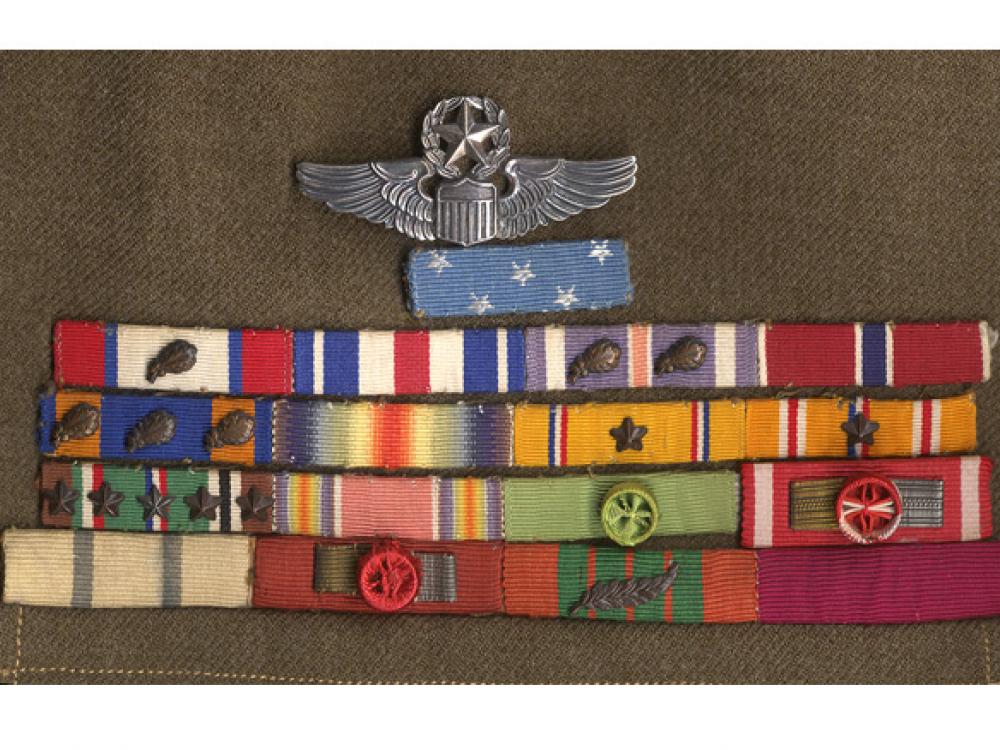
A Curator on Configuring WWII Military Medals
Apr 18, 2018
By Alex Spencer

Apr 18, 2018
By Alex Spencer
Over the years I’ve spent curating the National Air and Space Museum’s uniform and flight clothing collection, I have received many inquiries. One of the most frequently ask questions concerns the placement of Lt. Gen. Jimmy Doolittle's Medal of Honor ribbon on his wartime uniform. General Doolittle received the Medal of Honor for leading the daring flight of North American B-25 bombers off the deck of the aircraft carrier USS Hornet on April 18, 1942. This was the first strike by American aircraft on the Japanese home islands. Although the raid produced limited results, it had a profound impact on the course of World War II in the Pacific.
North American B-25 Mitchell Bombers on the deck of the U.S.S. Hornet in route to attack Japan. Credit: National Archives and Records Administration
The ribbon is located above the left breast pocket of General Doolittle’s uniform tunic on display at our Steven F. Udvar-Hazy Center in Chantilly, Virginia. The observational powers of the museum’s visitors never cease to amaze me: This tiny ribbon measures no more than 1.5 inch x 0.5 inch and it is located in a building that spans 760,057 square feet, yet many visitors point out a problem to me about the orientation of the ribbon’s five star pattern. The current military regulations state that the stars should be in an “M” pattern, two stars on the top row and three on the bottom row. On the Doolittle uniform this is reversed in a “W” pattern with three stars on the top row and two on the bottom row.
I have seen the regulations about wearing the medal ribbon but I have also seen historic photographs of General Doolittle wearing this very uniform with the medal’s stars in the “W” configuration. General Doolittle personally donated his uniform to the Museum in 1959 and Museum personnel never altered it. As you can imagine, I would feel extremely uncomfortable about cutting the medal ribbon off the uniform and making the change. It would be as though I was accusing General Doolittle of being wrong.
Lt. Gen. Jimmy Doolittle in his B-25 “Whirling Dervish” making his take off from the deck of the U.S.S. Hornet to make the first aerial attack on Tokyo on April 18, 1942. Credit: National Archives and Records Administration
After an extensive search, I was relieved to find, in the 1941 editions of an Army/Navy uniform regulation manual, an illustration confirming that the medal’s "old" ribbon pattern had the stars in a “W” configuration. This pattern originates from the exclusive contract that the Navy and War Departments gave the Tiffany Company to produce the nation’s Medal of Honor from 1920- 1940. I can confirm that General Doolittle’s Medal of Honor was one produced by the Tiffany Co. prior to the United States’ entry into WWII, so the “W” pattern is correct.
The “M” star configuration is now the standard, but I have been unable to determine when this was officially authorized. I assume that it was made with the passing of the 1947 National Security Act that created the United States Department of Defense. This act established a number of new accolades and standardized existing awards and medals.
We rely on the generous support of donors, sponsors, members, and other benefactors to share the history and impact of aviation and spaceflight, educate the public, and inspire future generations. With your help, we can continue to preserve and safeguard the world’s most comprehensive collection of artifacts representing the great achievements of flight and space exploration.